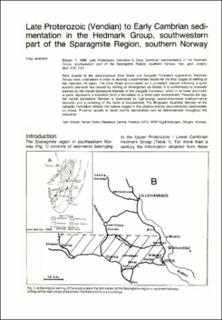| dc.contributor.author | Dreyer, Tom | |
| dc.coverage.spatial | 18161 Gjøvik | |
| dc.coverage.spatial | GJØVIK | |
| dc.coverage.spatial | 18164 Dokka | |
| dc.coverage.spatial | SØNDRE LAND | |
| dc.coverage.spatial | NORDRE LAND | |
| dc.date.accessioned | 2020-08-26T09:12:05Z | |
| dc.date.available | 2020-08-26T09:12:05Z | |
| dc.date.issued | 1988 | |
| dc.identifier.uri | https://hdl.handle.net/11250/2674263 | |
| dc.description.abstract | Field studies of the allochthonous Ekre Shale and Vangsås Formation (uppermost Hedmark Group) were undertaken in order to develop a sedimentary model for the final stages of infilling of the Hedmark rift basin. The Ekre Shale accumulated as a prodeltaic deposit following a quick eustatic sea-level rise caused by the Vardal Sandstone Member of the Vangsås Formation, which in its lower and middle parts represents a transition from a fan-deltaic to a braid-plain environment. Towards the top, the Vardal Sandstone Member is dominated by high-energy (wave-dominated) shallow-marine deposits, and a widening of the basin is documented. The Ringsaker Quartzite Member of the Vangsås Formation reflects the mature stages in this shallow-marine (epicontinental) sedimentation phase. Proximal (south) to distal (north) relationships can be demonstrated throughout the sequence. | |
| dc.language.iso | eng | |
| dc.relation.ispartofseries | NGU Bulletin (412) | |
| dc.rights | Navngivelse 4.0 Internasjonal | |
| dc.rights.uri | http://creativecommons.org/licenses/by/4.0/deed.no | |
| dc.subject | AVSETNING | |
| dc.subject | SANDSTEIN | |
| dc.subject | PREKAMBRIUM | |
| dc.title | Late Proterozoic (Vendian) to Early Cambrian sedimentation in the Hedmark Group, south-western part of the Sparagmite Region, southern Norway | |
| dc.type | Journal article | |
| dc.description.localcode | 36201 | |
| dc.source.pagenumber | 1-27 | |

